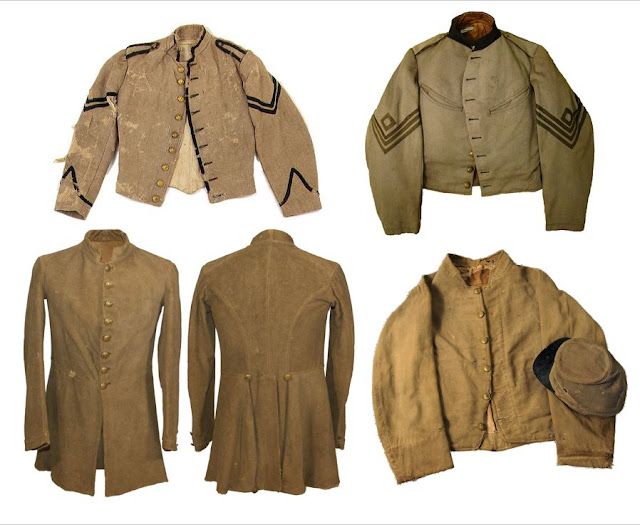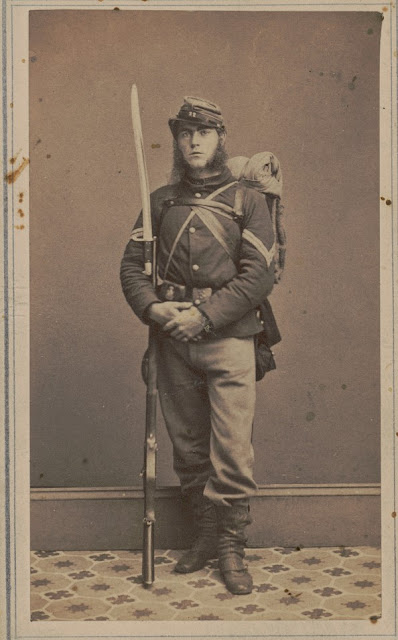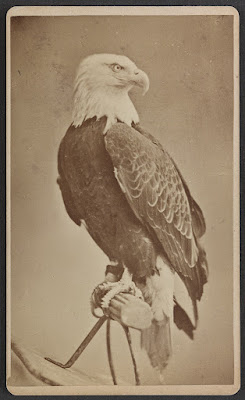I Carry the Bullet as a Memento: With Battery C at Chickamauga
Writing a short letter to his parents a week after the Battle of Chickamauga, Private Sherman Hendrick of Battery C, 1st Ohio Light Artillery reported that he had been wounded but assured them he could "kick around quite lively. I am wounded in the right shoulder and carry the bullet there as a memento, but don’t let it keep you awake at night for it don’t hurt me much."
Long after the war, Hendrick assembled a much longer article for the National Tribune giving a history of his battery's service at Chickamauga which is reproduced below along with his wartime letter. The battery photos appear courtesy of Larry Stevens' Ohio in the War website, the images originally belonging to an album owned by Sergeant Theodore Stoughton who figures prominently in Sherman Hendrick's narrative.
Nashville,
Tennessee
September 26, 1863
Dear
parents,
I presume you are worrying about me
but this is the first time I have found for writing. I am comfortably settled
here in the hospital but how long I shall stay I do not know for many will have
to be sent North. I cannot give you particulars now.
The battery was in the fight of the 19th
and 20th. The papers will tell you all about the fight and perhaps
that your boy is wounded for my name was taken. I am wounded in the right
shoulder and carry the bullet there as a memento, but don’t let it keep you awake
at night for it don’t hurt me much and by being helped up and down, I can kick
around quite lively.
I left the field on Monday morning for
Chattanooga and on Tuesday started for Bridgeport, leaving you to judge of the
hard time we had crossing the mountains in government wagons. At Bridgeport, we
took the cars and came here. My wound is not a bad one but it will take time to
heal being a gun wound.
Up until Monday I was the only
Ashtabula boy wounded except Daniel Horton and he was shot dead. Robert
Wilkinson of Saybrook was supposed to be killed; several others were wounded
from the battery. Our support on the right broke away so the Rebs had a
crossfire upon us. When we fired our last round they were not more than five
rods off. We then ran back the gun to limber up then I was wounded. We lost our
piece but the rest were saved.
But now came my work in earnest.
During the two days I had stood up to the rack and worked faithfully but now my
nerves were gone. I feared the Rebels would get me and I ran as long as I could
and sank down but was still between the two armies. I thought of my canteen,
took a drink, got up and went behind a house where I meant to stay until picked
up by one party or the other. Soon [Theodore] Stoughton came along with the
limber and loaded me on and so I escaped Mr. Reb this time.
But I have written enough for a man with a Rebel bullet in his shoulder…
By 1891,
Sherman had moved to Hutchinson, Kansas, to work as a minister. He wrote the
following article to the National Tribune providing a lengthier
description of his battery’s role in the fighting at Chickamauga.
At the time of the battle, we were
attached to the Second Brigade, Third Division (General Brannan), of the 14th
Army Corps and crossed the Tennessee River opposite the cornerstone of Georgia
and Alabama and Nickajack Cove on September 1, 1863. On Sunday the 6th
we crossed Sand Mountain into Lookout Valley and found the Rebel pickets in
front of Trenton. On the 8th there was some cannonading in front of
us as the troops were scattering in pursuit of the Rebels who we learned on the
9th had evacuated Chattanooga. On the 11th we heard
Negley’s guns over in Pigeon Valley but he was driven back and had to await
reinforcements.
General Bragg had been heavily
reinforced from the east and was coming back upon our scattered army,
determined to retake Chattanooga. That night, we crossed Lookout Mountain into
Pigeon Valley and found the hills ahead of us full of Rebels. From this time
until the battle, General Rosecrans was busy concentrating his troops. On the
18th we marched all night, passing through Rock Springs. The road
was well warmed and lighted by burning fences.
On the morning of the 19th
about 6 a.m. we parked to feed our horses and make coffee. Before we had time
to feed there was lively firing on the skirmish line and we were ordered to the
front immediately. We were told there was a brigade a Rebel cavalry in front of
us in the woods which we (Brannan’s division) were ordered to capture. We went
in and found the cavalry but they were backed by infantry at least three to our
one. We went into battery but did not fire a gun before we were ordered out of
there. C.H. Belknap was wounded while we were falling back.
We only fired four rounds during the day; the woods and brush
were so thick we could do nothing on account of the rapid movements of the
enemy but our infantry, how they surprised us! Battery C thought there was only
one other corps in the world that equaled the 14th Corps and that
was a the 20th, the consolidated 11th and 12th.
In the 14th Corps, we thought the Third Division was the best simply
because we were better acquainted with them, but of all brave men none could
beat the Third Division in that day’s fighting against such overwhelming
numbers. Three times were they driven back through the thick brush and three
times did they charge and retake the field. The sight was simply grand. I will
not name the regiments; everyone knows the gallant troops that comprised that
division. They were all heroes and had heroic commanders from General George H.
Thomas down to the line officers.
 |
| General George H. Thomas |
The third time they were repulsed that afternoon came near
being a rout; the Rebel forces were sweeping on in triple line of battle
against our single line. The brush was so thick we could not get away fast
enough with our useless artillery and Battery C was in danger of being
captured. Only a thin line two deep stood between the muzzles of our guns and
the surging masses of the enemy. Something must be done or the guns are lost.
The 600-man strong 10th Kentucky halted and we heard the command, “Halt!
About face! Charge!” There is no need of the command double quick for there are
not six paces between them. I gazed in wonder at that handful of men being
hurled against that wall of steel. Only a moment the Rebel line wavered in
astonishment, then a blaze of musketry, and the 10th Kentucky melted
away. Only 200 answered at roll call that night, but the battery was saved and
those men went down in a hail of glory.
But this relief was only temporary as the enemy was driving
us through the woods in increasing confusion. The infantry was driven back even
among our useless cannon and the enemy was so close they could lay their hands
upon the muzzles of the guns. In this condition, we met General Thomas on a
little rise of ground sitting upon his horse as calmly as though he was taking
his coffee, while the bullets flew around him as thick as hail. It was
encouraging to see Pap Thomas at any time and especially such a time, but when
he spoke, the effect of his words was almost magical. “Soldiers of the Third
Division, halt! Why do you flee in such confusion? You have met this same enemy
before. You whipped them at Mill Springs and you can do it again!”
Even the enemy could hear him as he shouted, “About face,
charge!” The order was instantly obeyed and such a charge as they made. The
enemy fled before them like frightened sheep and for a time the tide of battle
tolled away. The Third Division, which up to this time had occupied the extreme
left of the army, was now relieved by two divisions of the 20th Army
Corps and went to the right and rear for the night. We parked on a hill at 10 p.m.
and rested until 3 a.m. on the 20th when we went to the front. Our
flanking pieces were 12-lb Napoleons and the rest were 6-lb James rifles, all
brass pieces. The two Napoleons were placed on the front line where the
infantry had built a small breastwork of logs and brush about two feet high so
the muzzles of the guns would just clear the top.
Soon the tide of battle, which had been muttering all the
morning on the left, rolled toward the right and the artillery kept up a
continued roar until it reached our two pieces. The Rebels were hurled back
before our charges of canister. During this fight, Sergeant [George M.] Salkeid
stood upon the works watching the approaching enemy and telling his gunner
where to fire. As the other four pieces lay back in the woods waiting orders
and taking all the back fire, I could not find a tree big enough to cover me, but
as soon as the first charge was repulsed and we were ordered to the front, I
forgot my fears and felt strong enough to carry a cannon all alone.
 |
| General John M. Brannan, commanding Third Division, 14th Army Corps |
The remaining pieces of the left and right sections took
places next to the Napoleons on their right while the center section took the
extreme right of the battery. I am not certain whether there was another
battery to the right of us in Brannan’s division or not. About half an hour of
quiet was all that was given us in which to take our places at the front when
the roar of artillery was heard again on the left. It came towards us in a
manner that made us feel rather shaky again.
We were watching for the approaching foe and soon saw them,
their bayonets glistening in the morning sun. Then we were ordered to commence
firing. They charged up to within six rods of our muzzles when our canister
hurled them back. We had lots of canister but no grape although I notice that
infantrymen always speak of grape and canister. The second charge they came
nearer and we mowed them down in windrows. We could keep our front clear as
long as our flanks were protected and the canister held out.
 |
| Canister |
A third time they came on. Between the second and third
charge General Wood made that unaccountable blunder of withdrawing his division
from the front and passing to our division’s rear to the support of Reynolds on
our left. We had not much more than begun our morning operations against this
third charge when we noticed bullets coming from our right. We turned our guns
in that direction. When we fired our last charge, the Rebels were not two rods
away. I cannot say much for any but our own section, only that Battery with
Lieutenant Marco Gary commanding, covered itself with glory that day. Our
section was badly cut to pieces in that flank charge.
I was the No. 2 on our gun which we called the Ashtabula gun;
Daniel Horton was No. 4. He was shot down and did not move after he fell. Then
Barnhart Reichart, our No. 3, acted for both. Albert A. LeClere was No. 1. He
had just said to me that he could not hold out much longer and I was thinking
of taking hold to help him when he was wounded in the head, dropped the sponge
staff, and turned away. I sprang across the muzzle of the gun and picked up the
sponge staff to take his place when Amos Austin of the Madison gun came up with
his staff in hand and said, “Let me act. Our gun is disabled. Gunner Hasell in
badly wounded.” I at once resumed my own post. We fired perhaps half a dozen
times more then were ordered to limber up and Austin returned to help save his
own piece. As we were running off our gun, I was wounded and there was not
enough men left to get the gun through the brush.
 |
| Sergeant Theodore Stoughton Battery C, 1st OVLA |
Sergeant Theodore Stoughton and Barnhart Reichart dismounted it,
however, and escaped just as the Johnnies were on the point of laying hands on
them. How they came off alive I do not know. Stoughton came out with the gun
limber and three horses, ridden by Johnson and Ingersoll; they picked me up so
I rode off the field on the gun limber. The Madison gun was brought off by John
Austin with his wheelers. All the other horses were either killed or wounded
and had to be cut out. The other two sections lost two or three caissons and
several horses.
The battery being so badly disabled was sent off the field towards Chattanooga. We did not lose near as many men in proportion as our infantry supports in the two days’ fighting. Battery C did its best under the circumstances but we were satisfied from the looks of things when we left the field that our battery had not saved the army. Some who came in after we left the field claimed that honor.
Sources:
Letter from Private Sherman Hendrick, Battery C, 1st Ohio Volunteer Light Artillery, Ashtabula Weekly Telegraph (Ohio), October 10, 1863, pg. 3
“Chickamauga:
The Part Taken in the Great Battle by Battery C, 1st Ohio L.A.,”
Corporal Sherman Hendrick, Battery C, 1st Ohio Volunteer Light
Artillery, National Tribune, November 5, 1891, pg. 4














Comments
Post a Comment